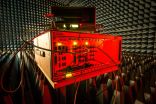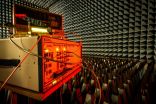(Press-News.org) Radio systems, such as mobile phones and wireless internet connections, have become an integral part of modern life. However, today's devices use twice as much of the radio spectrum as is necessary. New technology is being developed that could fundamentally change radio design and could increase data rates and network capacity, reduce power consumption, create cheaper devices and enable global roaming.
A pioneering team of researchers from the University of Bristol's Communication Systems and Networks research group, have developed a new technique that can estimate and cancel out the interference from one's own transmission, allowing a radio device to transmit and receive on the same channel at the same time. This therefore requires only one channel for two-way communication, using half as much spectrum compared to the current technology.
Leo Laughlin, a PhD student from the University's EPSRC Centre for Doctoral Training (CDT) in Communications, together with MSc student Chunqing Zhang, supervisors Professor Mark Beach and Dr Kevin Morris, and industrial mentor, Dr John Haine at u-blox, have designed and built a novel full-duplex transceiver architecture, which combines electrical balance isolation and active radio frequency cancellation. Their prototype can suppress interference by a factor of over 100 million and uses low-cost, small form factor technologies, making it well suited to use in mobile devices such as smartphones and tablets.
This important change in radio design could offer a range of benefits. In Wi-Fi systems this would double the capacity of a Wi-Fi access point, allowing more users and higher data rates. For cellular systems, full-duplex operation would also deliver increased capacity and data rates, or alternatively the network operators could provide the same total network capacity with fewer base station sites, giving obvious benefits in the cost and environmental impact of running the network.
Leo Laughlin, who is in the first cohort of students in the CDT in Communications, said: "Until now there has been a fundamental unsolved problem with radio communication. Since the radio spectrum is a limited resource, and with network operators paying billions of pounds to access the spectrum, solving this problem would bring us one step closer to the faster, cheaper and greener devices of our connected future."
As well as being part of the evolution to 5G mobile, this research is also very relevant to the design of the radio circuitry in current 3G and 4G cellular mobile devices. In today's mobile devices, a separate filtering component is required for each frequency band, and because of this, today's mobiles phone do not support all of the frequency channels which are in use across the world. Different devices are manufactured for different regions of the world, and there are currently no 4G phones capable of unrestricted global roaming. Replacing these filters with the research team's duplexer circuit would create smaller and cheaper devices, and would allow manufacturers to produce a single model for the entire world. This would enable global roaming on 4G and would further decrease cost through greater economies of scale.
Mark Beach, Professor of Radio Systems Engineering, commented: "In addition to EPSRC's investment in Doctoral Training Centres at Bristol, we have also been awarded equipment funding. Leo and Chunqing have taken full advantage of the new laboratory facilities in the validation and optimisation of our full-duplex architecture."
The team have published papers about their research in the IEEE Journal on Selected Areas in Communications special issue on full duplex radio, and in this month's issue of the IEEE Communications Magazine, and patents have been filed to protect the novel duplexer design.
INFORMATION:
Paper:
Electrical balance duplexing for small form factor realization of in-band full duplex by Leo Laughlin, Mark A. Beach, Kevin A. Morris, and John L. Haine in IEEE Communications Magazine.
Paper:
Optimum single antenna full duplex using hybrid junctions by Leo Laughlin, Mark A. Beach, Kevin A. Morris and John L. Haine in IEEE Journal on Selected Areas in Communications.
Oral care products containing a natural chemical that stops bacteria harming teeth could help prevent decay, a study suggests.
The plant natural product acts against harmful mouth bacteria and could improve oral health by helping to prevent the build-up of plaque, researchers say.
The compound - known as trans-chalcone - is related to chemicals found in liquorice root. The study shows that it blocks the action of a key enzyme that allows the bacteria to thrive in oral cavities.
The bacteria - Streptococcus mutans - metabolise sugars from food and drink, which produces ...
Some mountain gorilla females linger into adulthood in the group into which they were born. In the process, they also remain in the company of their father, who is often their group's dominant male. To curb inbreeding, though, they appear to tactically avoid mating with their fathers. This strategy works so well that the chances of alpha gorilla males siring the offspring of their own daughters are effectively zero, according to Linda Vigilant of the Max Planck Institute for Anthropology in Germany. The findings are published in Springer's journal Behavioral Ecology and ...
CAMBRIDGE, Mass--Researchers have found a way to couple the properties of different two-dimensional materials to provide an exceptional degree of control over light waves. They say this has the potential to lead to new kinds of light detection, thermal-management systems, and high-resolution imaging devices.
The new findings -- using a layer of one-atom-thick graphene deposited on top of a similar 2-D layer of a material called hexagonal boron nitride (hBN) -- are published in the journal Nano Letters. The work is co-authored by MIT associate professor of mechanical engineering ...
The rapid evolution of gadgets has brought us an impressive array of "smart" products from phones to tablets, and now watches and glasses. But they still haven't broken free from their rigid form. Now scientists are reporting in the journal ACS Applied Materials & Interfaces a new step toward bendable electronics. They have developed the first light-emitting, transparent and flexible paper out of environmentally friendly materials via a simple, suction-filtration method.
Technology experts have long predicted the coming age of flexible electronics, and researchers have ...
Scientists from General Atomics and the U.S. Department of Energy's (DOE) Princeton Plasma Physics Laboratory (PPPL) have discovered a phenomenon that helps them to improve fusion plasmas, a finding that may quicken the development of fusion energy. Together with a team of researchers from across the United States, the scientists found that when they injected tiny grains of lithium into a plasma undergoing a particular kind of turbulence then, under the right conditions, the temperature and pressure rose dramatically. High heat and pressure are crucial to fusion, a process ...
(PARIS, FRANCE) - Clearing blood clots from arteries during treatment for an acute myocardial infarction was a relatively common practice until a recent, large-scale study showed that the technique, known as thrombectomy, might actually increase the risk of stroke. Now, new insights from the TOTAL trial, presented here at EuroPCR 2015, indicate that the risk of stroke with thrombectomy during angioplasty, compared to angioplasty alone is evident very early following the procedure.
Dr. Sanjit Jolly, the study's lead author and an interventional cardiologist and Associate ...
This beautiful planetary nebula is named after a dreadful creature from Greek mythology -- the Gorgon Medusa. It is also known as Sharpless 2-274 and is located in the constellation of [Gemini] (The Twins). The Medusa Nebula spans approximately four light-years and lies at a distance of about 1500 light-years. Despite its size it is extremely dim and hard to observe.
Medusa was a hideous creature with snakes in place of hair. These snakes are represented by the serpentine filaments of glowing gas in this nebula. The red glow from hydrogen and the fainter green emission ...
Noise from pile driving during offshore wind turbine construction could be damaging the hearing of harbour seals around the UK, according to ecologists who attached GPS data loggers to 24 harbor seals while offshore wind turbines were being installed in 2012. Data on the seals' locations and their diving behaviour was combined with information from the wind farm developers on when pile driving was taking place. Models revealed that half of the tagged seals were exposed to noise levels that exceeded hearing damage thresholds.
There are currently 1,184 offshore wind turbines ...
The harlequin ladybird, officially known as Harmonia axyridis, was widely introduced across continental Europe as a way to limit the population of small sap-sucking insects called aphids. While it was never intentionally introduced into Britain, H. axyridis was discovered there in 2003, and people across the region have been tracking its spread since 2005.
A new review in The Royal Entomological Society's journal Ecological Entomology notes that tens of thousands of people have provided records of H. axyridis and other species of ladybirds, creating an invaluable dataset ...
Gun violence restraining orders (GVROs) are a promising strategy for reducing firearm homicide and suicide in the United States, and should be considered by states seeking to address gun violence, researchers from the Johns Hopkins Center for Gun Policy and Research at the Johns Hopkins Bloomberg School of Public Health and the University of California, Davis, argue in a new report.
The article is being published online in Behavioral Sciences and the Law on May 20.
GVROs allow family members and intimate partners who believe a relative's dangerous behavior may lead ...




